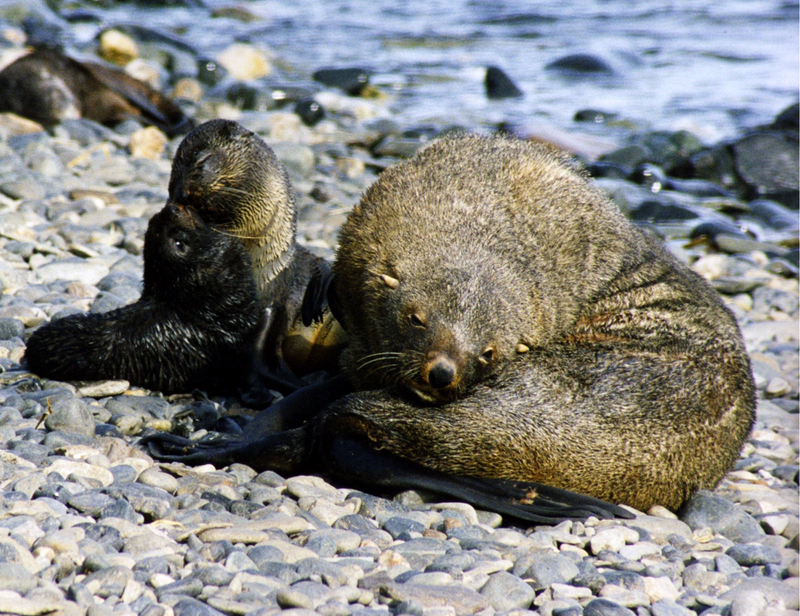| 새로운 사진 | 신문속의 동물소식 | 신기한 동물이야기 | 동물의 소리 | 동물동화상 | 사진 올리기 | 사진 저작권 | English |
|---|
| 재미있는 동물사진 | 괴수/괴어/엽기 동물사진 | 동물이름사전 | 동물목록 | 바깥고리 | 창고입구 | 똑똑누리집 |
|---|
| 이미지 정보 | Original File Name: Fur_seals_at_south_georgia-Antarctic Fur Seal (Arctocephalus gazella).jpg Resolution: 1536x1182 File Size: 1636748 Bytes Date: 2007:10:31 10:09:15 Upload Time: 2007:12:20 16:51:16 | |
| 올린이 | 이름 (메일주소): Unknown | |
| 사진 제목 | Antarctic Fur Seal (Arctocephalus gazella) - Wiki | |
 |
| Email : 카드 | 올린이 | 운영자 사진삭제 정보수정 Admin |
| 설명 | Antarctic Fur Seal (Arctocephalus gazella) - Wiki
Antarctic Fur Seal
The Antarctic Fur Seal (Arctocephalus gazella) is one of seven seals in the genus Arctocephalus. As its name suggests, the Antarctic Fur Seal is distributed in Antarctic waters. Around 95% of the world population breeds at South Georgia. It is named for the German naval vessel the SMS Gazelle which collected the first specimen from Kerguelen Island. The species is also known as the Kerguelen Fur Seal. Physical description This fur seal has a short and broad snout compared with others in the family. Adult males are dark brown in colour. Females and juveniles tend to be grey with a lighter underside. Colour patterns are highly variable, and some scientists believe that some hybridisation with subantarctic fur seals has occurred. Pups are dark brown, nearly black at birth. About one in 1000 Antarctic fur seals are pale 'blonde' variants. Males are substantially larger (2 m, 200 kg) than females (1.35 m, 40 kg). Males live for about 15 years and females up to 25. Antarctic Fur Seals appear to act alone when foraging and migrating. Males breed polygynously ??? a strong male may have more than a dozen female partners in a single season. Territories are established on breeding grounds in October to early November, when the musty-smelling males are extremely aggressive in defence of their harems. Females gestate for just over a year - giving birth in November or December. Pups are weaned at about month old. Juveniles may then spend several years in the water before returning to begin their breeding cycle. The usual food supply is krill, and each Antarctic Fur seal eats about a ton of krill each year. Due to the enormous and growing populations of these seals, their food is a significant proportion of South Georgia's krill stocks. Range and population The Antarctic Fur Seal breeds in summer on islands ranging from South Georgia at 70° W round to about 80° E (Kerguelen Islands). Additionally there is a breeding ground at Macquarie Island, 165°E - south of New Zealand. All of these islands are between 45° S and 60° S. The animal's winter range is not known. During these long dark months, the seal spends its time almost surely close to the Antarctic ice ??? spending virtually its time at sea. A population count is due in 2007 or 2008, and estimates can only be very rough until this is carried out. Best guesses suggest there may be two to four million individuals breeding at South Georgia and 15,000 at Heard Island. The concentrations at South Georgia are the densest aggregations of marine mammals on earth. Some people believe these populations have grown to such levels because the removal of whales by the intensive whaling of the 20th century left a surplus of krill. Other islands in Antarctic waters may have a few hundred to a thousand such seals. Human interaction The Antarctic Fur Seal was very heavily hunted in the eighteenth and nineteenth centuries for its pelt by sealers from the United States and the United Kingdom. By the early twentieth century, the seal was regarded as commercially extinct, and perhaps completely extinct. In fact a small population continued to exist, breeding on Bird Island in South Georgia. This colony has expanded rapidly over the course of a century. The current populations on the other Antarctic islands are believed to be off-shoots of this one colony. The species is still protected by the governments in whose waters it resides (Australia, South Africa) and by the Convention for the Conservation of Antarctic Seals in waters south of 60° S. The animal is also listed in Appendix 2 of CITES. However some governments with interests in the Antarctic, for instance, the United Kingdom, say that some of these protections should be lifted as the species is causing damage to vulnerable Antarctic plants. http://en.wikipedia.org/wiki/Antarctic_Fur_Seal
| |||
| 저작권 정보 | 사진의 저작권은 원저작자에게 있습니다. 동물그림창고는 동물관련 사진을 전시할 수 있는 공간만을 제공합니다.사진을 사용하고자 할 경우에는 저작권자와 협의하시기 바랍니다. |
|
|
|
| |||||||
| CopyLeft © since 1995, 동물그림창고. All rights may be reserved. | ||||||||
Stats